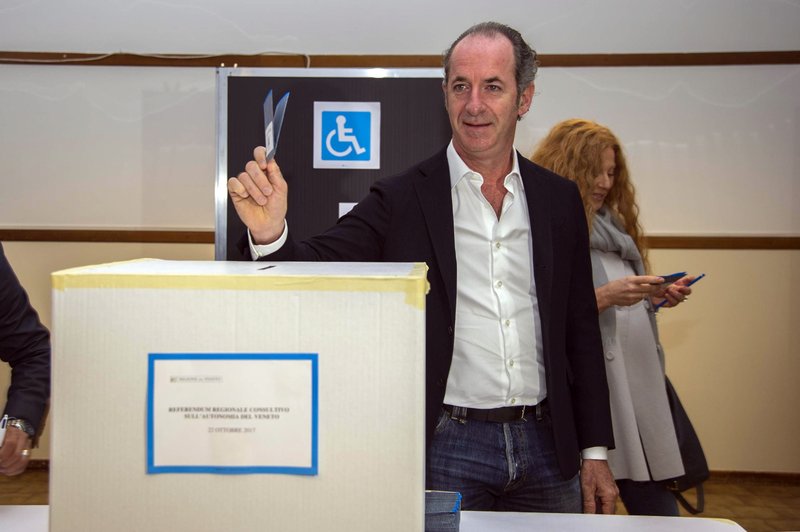MILAN -- Voters in the wealthy northern Italian regions of Lombardy and Veneto voted overwhelmingly Sunday to seek greater autonomy from Rome.
Lombardy President Roberto Maroni said 95 percent of voters approved of autonomy in unofficial results. No tallies were available in neighboring Veneto, though Veneto President Luca Zaia said the "yes" vote also won there.
While the twin referendums are nonbinding, the vote gives the presidents more leverage in negotiations to seek a greater share of tax revenue from Italy's center-left government. As leading members of the anti-migrant Northern League, a regional political party that opposes the central control of the European Union, the two presidents also want autonomy over such policy areas as immigration, security, education and the environment.
Unlike in Spain's Catalonia region, the referendums did not seek independence and had been approved by Italy's constitutional court. Still, the autonomy drive is a powerful threat to Rome's authority. The two regions host two of Italy's most famed cities -- Venice and Milan. Together, Veneto and Lombardy account for nearly 25 percent of Italy's electorate, but 30 percent of the nation's GDP. The referendum campaign focused on the idea that too much of northern Italy's tax revenue was going to the nation's southern regions.
"This is the big bang of institutional reform," Zaia said in Venice. "We are convinced, and I hope Rome understands, that this is not the wish of a political party. These are the wishes of the people."
In Milan, Maroni said that with the votes, the two regions "can unify our forces so we can do the battle of the century."
The two leaders say they will meet with their regional councils to finalize their requests before going to Rome to meet with Premier Paolo Gentiloni.
In Veneto, 60 percent of the region's 4 million voters cast ballots. In Lombardy, the turnout was lower, but still above 40 percent of the 8 million voters -- exceeding the target that Maroni set for success.
The victory raises the Northern League's profile ahead of national elections next year. The party was founded with the goal of secession for the wealthier, more productive northern regions, but it gave that up when it joined the national government under then-Premier Silvio Berlusconi in the 1990s. Autonomy has become the new expression of the party's identity politics.
Also supporting the referendums were the populist 5-Star Party and former Prime Minister Silvio Berlusconi's Forza Italia, or Forward Italy.
The referendum victory is just the first step as the regions seek greater autonomy. Some of the key areas where the two northern regions want more autonomy -- including greater fiscal control, immigration and security issues -- are beyond the scope defined by the constitution, thereby requiring difficult-to-achieve constitutional changes.
"I don't think this is possible," said Paolo Natale, a political scientist at Milan's state university. "It will be difficult for the state to accept that they take over education and security policy. The management of immigration policy has to be done at a national level."
Critics argue the nonbinding votes carry no legal weight, are not needed to trigger autonomy negotiations and are a costly waste of resources.
Yet such arguments played into the hands of the "yes" campaigners, who see such put-downs as part of the anti-democratic, centrist decision-making in Rome.
The Italian constitution already grants varying levels of autonomy to five regions in recognition of their special status: the largely German-speaking Trentino-Alto Adige; the French-speaking Aosta; the islands of Sardinia and Sicily; and the region of Friuli-Venezia Giulia for its position on the border with then-Yugoslavia as a Cold War hedge.
A Section on 10/23/2017
